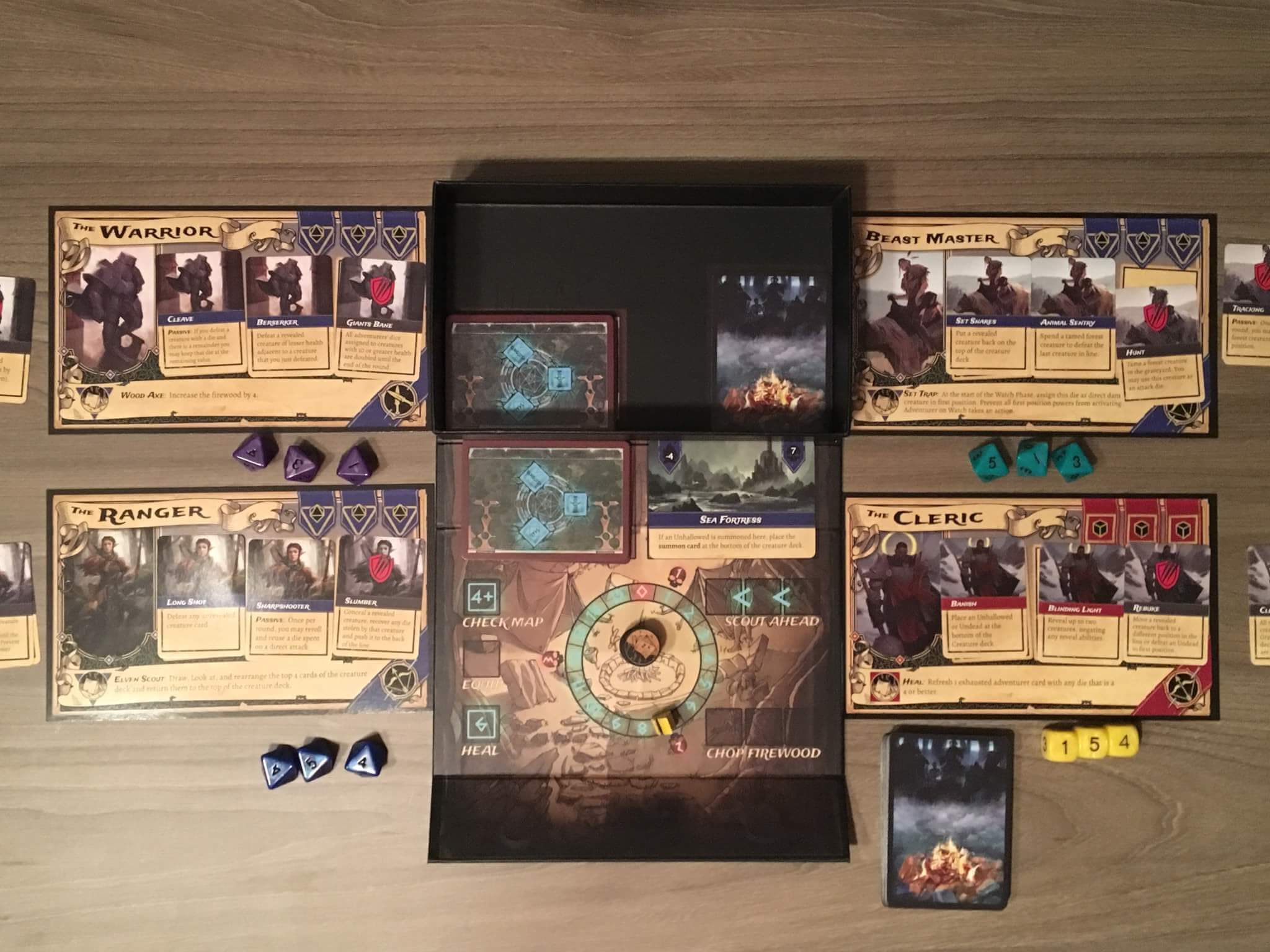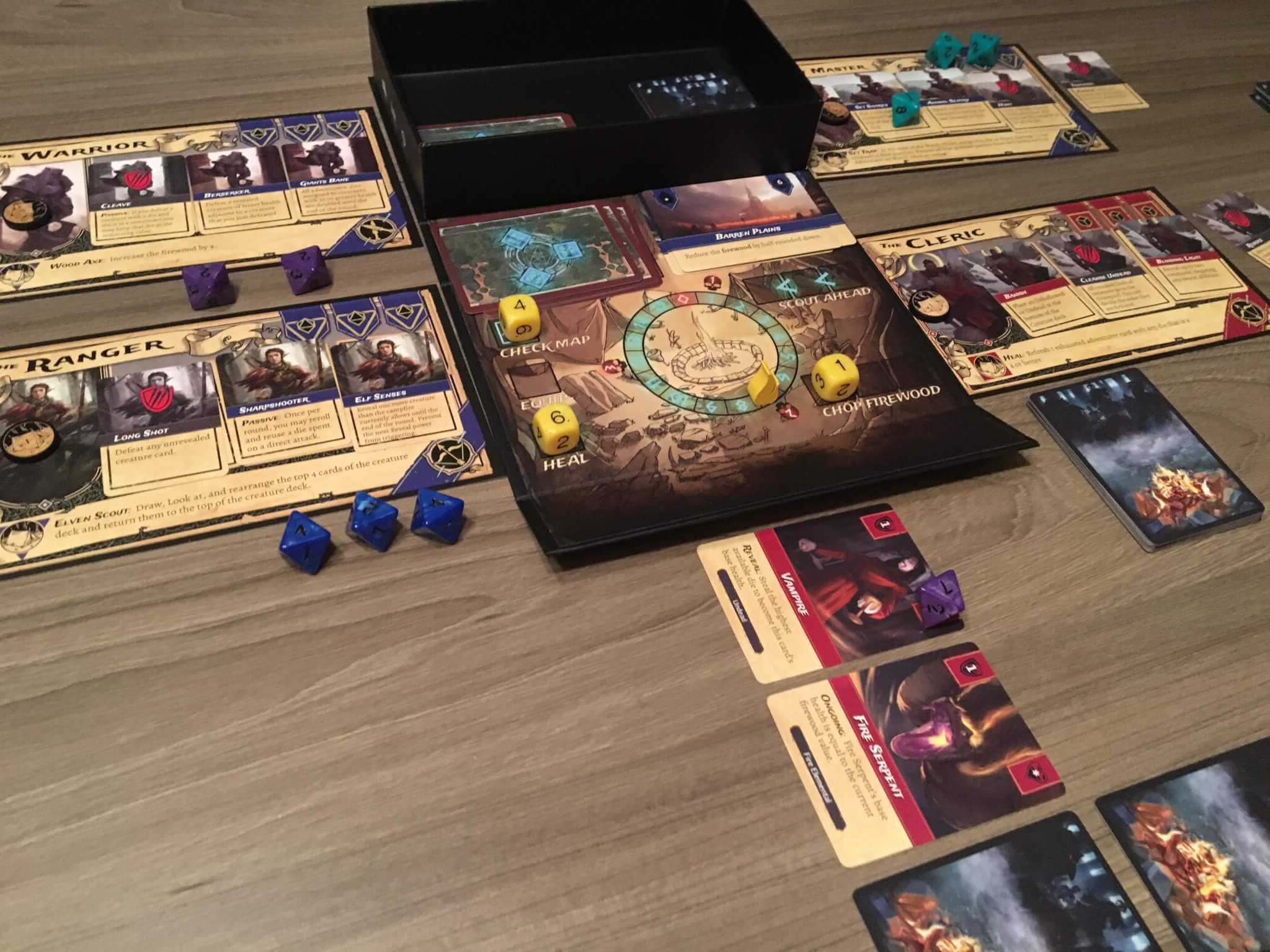
An icy wind rushes into the cavern where you and your companions huddle around a meagre campfire. The flames rush upwards in the gust, throwing their light onto the glistening, icy walls. As the flames die down, you notice that there are other things shimmering in the darkness that are moving closer and closer. This can mean only one thing; it’s time to Set a Watch.
Set a Watch is a single player or cooperative experience that pits a party of exactly four adventurers against wave after wave of enemies, before a final encounter takes place. With card based abilities and dice rolling in their arsenal, the players will manipulate the battlefield and attempt to defeat as many enemies as they can each wave, with any left over monsters joining a horde that will reappear later.
Aside from the obvious challenges that these monsters pose and the fact that the heroes will become ever more exhausted as the game rolls on, there’s also a need to maintain the campfire. Each round, one hero will not participate in the battle, and instead must chop firewood, heal (to recover an exhausted ability) and perform scouting actions that relate to the enemy and location decks.

What makes matters worse is the fact that each hero must watch the campfire at least twice during every game (there are always eight rounds plus a final encounter.) This means that it’s impossible to buff or maintain one or two strong heroes whilst leaving behind someone who has powerful campfire abilities. No matter how terrible the next watch is likely to be, it is sometimes necessary to send a strong hero to the campfire whilst a weaker one steps forward.
Managing the campfire (and who will stay with it) is a key strategy in Set a Watch, as are the campfire actions of scouting ahead to pick a more favourable location, and stacking the enemy deck as favourably as you can. Scouting enemies allows the campfire player to look at the first two monster cards and then to reorder them, or put both at the bottom of the deck.
Scouting locations can sometimes result in one of the respite locations (which are excluded during setup) being brought back into the game. Each character also has their own special campfire action, and these range from the likes of being able to chop more wood, to being able to recover someone else’s exhausted ability, which is important, since healing is only usually possible with a six is rolled and then spent in camp.

On that note, each character has either six or eight sided dice associated with them, depending on their class. At the beginning of each round, the players will roll their dice and lock them in for use, then draw enemy cards in a line based on what location they are at. The location deck also sets how much firewood will be burned, with penalties being applied for falling below zero.
Depending on how bright the campfire is, the players will be able to see the first one, two or three monsters in the line, which will then be placed face up. With one player back at the campfire, the other three are then free to spend their dice on either direct damage (hurting a foe based on the amount shown on the die) or on using abilities. Placing on die on an ability is fine, but using that ability again (with a second die) will exhaust it, causing it to flip.
The aim of each round of Set a Watch is to clear the whole line of enemies, if possible, or at the very least to send only one or two very weak ones to the Horde, which will reappear during the final round. This, frankly, is very hard to achieve, and only through acute management of your abilities, combined with both luck of the dice and the draw will it be achieved.

This isn’t too bad when playing solo, since frustration, luck and randomness tends to influence solo games like Solitaire, but when playing cooperatively, it can be a bit disheartening and definitely leads to “alpha gaming,” when one player has a strong opinion about how best to defeat the current challenge, and chooses to try and railroad other players towards that goal.
Even if luck was less of a factor, Set a Watch is still tough to beat. Bearing in mind that a D6 or D8 is only capable of rolling at most a six or an eight respectively, and players have a total of nine dice in play, that leads to an absolute maximum damage output of 72 (based on 9 D8’s all rolling an eight.) Most locations will spawn six or more enemies, and the majority of these will have between seven and twenty health, and I don’t think I’ve ever seen a line defeated with direct damage alone.
Proper use of abilities is therefore critical to success, as is timing. One example relates to the placement of monsters in the line — some monsters have reveal abilities, whilst others have abilities that relate to being first or second in the line. It can sometimes be beneficial to attack a monster that is further back, before it gains a bonus for being first in the line. Some monsters protect those adjacent to them, whilst sometimes you’ll be hoping for good luck (again) thanks to abilities like the ranger hero’s long shot, which targets and kills any unrevealed monster.

When the final location (listed as the final location and drawn from a separate deck at random) is revealed, players follow the normal instructions for the location, and also introduce any cards in the horde deck. This deck will be made up of all monsters that have previously escaped, plus those who have been added through other means during the game. If the players cannot defeat this deck, then they lose the fight and will need to begin again.
One of the downsides that I see in how Set a Watch plays is that even though each character has five abilities, they can only ever play with three. Some characters, on rare occasions, can swap their skills, but it’s not the norm to do so and there’s no “level up” mechanic to make heroes more powerful. You end the game as you start it.
This essentially means that if you let even a handful of enemies escape to the horde, you’re very likely going to be beaten — because it’s not like there will be fewer of them later, on the contrary, in fact. Equally, you’ll be no stronger and by the end of the game, you’ll likely have several exhausted abilities across your party and possibly other issues (such as a lack of firewood) to contend with.

By working methodically and gaining a clear insight into how each character works (and what abilities they have,) it is possible to defeat Set a Watch, but it’s never easy. That’s a good thing though, especially for the solo gamer, since the nature of the game is random in terms of setup and to some extent outcome, and because it is intended to be infinitely replayable (and, I dare say, expandable).
If you’re interested in solo or (to a lesser extent) cooperative games, then Set a Watch delivers a robust and challenging experience with a lot of scope for trying different combinations. Rolling dice and drawing cards do compound the randomness, but the freedom to act in any turn order (including having players use one die, then pass, then use another one etc) can mitigate what would usually be an impossible challenge.
The components in my deluxe edition are really good, but the standard edition doesn’t lack for much and offers very good value considering how many hours of play you can achieve from the game. Overall, I’d rate Set a Watch as a very good solo game and one that I will return to, but you do need to be a little resilient to the luck factor, and I’d say that the cooperative play is weaker, simply because of how the game tends to shake out.
You can find out more information on Set a Watch on their website.